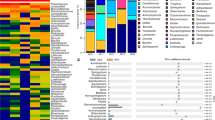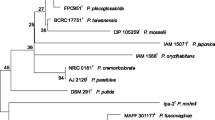Abstract
Given that the intensive application of sulfonamides in aquaculture, animal husbandry and malaria treatment has lead to an increase in sulfonamide discharge into the environment, there is an increasing need to find a way to remediate sulfonamide-contaminated sites. The bacterial strain DX7 was isolated from a marine environment and is capable of degrading sulfadoxine. DX7 was identified as a Pseudomonas sp. based on 16S rRNA gene sequencing. Approximately 30% of sulfadoxine was degraded after Pseudomonas sp. DX7 was inoculated into mineral salt plus tryptone media containing 10 mg l−1 sulfadoxine for 2 days. The degradation efficiency under different environmental conditions was characterized using HPLC. The optimal temperature and pH for sulfadoxine biodegradation were around 30°C and 6.0, respectively. The optimal concentrations of sulfadoxine and tryptone for sulfadoxine biodegradation were determined to be approximately 30 mg l−1 and between 2.0 and 8.0 g l−1, respectively. Cytotoxicity analysis indicated that the metabolites of sulfadoxine generated by Pseudomonas sp. DX7 showed significantly reduced cytotoxicity to Hela cells. These results suggest that Pseudomonas sp. DX7 is a new bacterial resource for degrading sulfadoxine and indicate the potential of the isolated strain in the bioremediation of sulfadoxine-contaminated environments.








Similar content being viewed by others
References
Aziken ME, Akubuo KK, Gharoro EP (2011) Efficacy of intermittent preventive treatment with sulfadoxine-pyrimethamine on placental parasitemia in pregnant women in midwestern Nigeria. Int J Gynaecol Obstet 112:30–33
Barnes KK, Kolpin DW, Furlong ET, Zaugg SD, Meyer MT, Barber LB (2008) A national reconnaissance of pharmaceuticals and other organic wastewater contaminants in the United States–I) groundwater. Sci Total Environ 402:192–200
Conteh L, Patouillard E, Kweku M, Legood R, Greenwood B, Chandramohan D (2010) Cost effectiveness of seasonal intermittent preventive treatment using amodiaquine & artesunate or sulphadoxine-pyrimethamine in Ghanaian children. PLoS One 17:e12223
Craig CR, Stitzel RE (1994) Modernpharmacology. 4, New York
Fent K, Weston AA, Caminada D (2006) Ecotoxicology of human pharmaceuticals. Aquat Toxicol 76:122–159
Focazio MJ, Kolpin DW, Barnes KK, Furlong ET, Meyer MT, Zaugg SD, Barber LB, Thurman ME (2008) A national reconnaissance for pharmaceuticals and other organic wastewater contaminants in the United States–II) untreated drinking water sources. Sci Total Environ 402:201–216
Halling SB, Nors NS, Lanzky PF, Ingerslev F, Holten Lützhøft HC, Jørgensen SE (1998) Occurrence, fate and effects of pharmaceutical substances in the environment-a review. Chemosphere 36:357–393
Heberer T (2002) Occurrence, fate, and removal of pharmaceutical residues in the aquatic environment: a review of recent research data. Toxicol Lett 131:5–17
Jesús García-Galán M, Silvia Díaz-Cruz M, Barceló D (2008) Identification and determination of metabolites and degradation products of sulfonamide antibiotics. Trends Anal Chem 27:1008–1022
Khetan SK, Collins TJ (2007) Human pharmaceuticals in the aquatic environment: a challenge to green chemistry. Chem Rev 107:2319–2364
Kim SD, Cho J, Kim IS, Vanderford BJ, Snyder SA (2007) Occurrence and removal of pharmaceuticals and endocrine disruptors in South Korean surface, drinking, and waste waters. Water Res 41:1013–1021
Kofoed PE, Rodrigues A, Aaby P, Rombo L (2006) Continued efficacy of sulfadoxine-pyrimethamine as second line treatment for malaria in children in Guinea-Bissau. Acta Trop 100:213–217
Kolaczinski K, Durrani N, Rahim S, Rowland M, Kolaczinski K, Durrani N, Rahim S, Rowland M (2007) Sulfadoxine-pyrimethamine plus artesunate compared with chloroquine for the treatment of vivax malaria in areas co-endemic for Plasmodium falciparum and P. vivax: a randomised non-inferiority trial in eastern Afghanistan. Trans R Soc Trop Med Hyg 101:1081–1087
Kostopoulou M, Nikolaou A (2008) Analytical problems and the need for sample preparation in the determination of pharmaceuticals and their metabolites in aqueous environmental matrices. Trends Anal Chem 27:1023–1035
Kuhn EP, Suflita JM (1989) Anaerobic biodegradation of nitrogen-substituted and sulfonated benzene aquifer contaminants. Hazard Waste Hazard Mater 6:121–133
Kümmerer K (2004) Resistance in the environment. J Antimicrob Chemother 54:311–320
Lane D, Pace B, Olsen G, Stahl D, Sogin M, Pace N (1985) Rapid determination of 16S ribosomal sequences for phylogenetic analyses. Proc Natl Acad Sci 82:6955–6959
Li B, Zhang T (2010) Biodegradation and adsorption of antibiotics in the activated sludge process. Environ Sci Technol 44:3468–3473
Loffler D, Ternes TA (2003) Determination of acidic pharmaceuticals, antibiotics and ivermectin in river sediment using liquid chromatography-tandem mass spectrometry. J Chromatogr A 1021:133–144
Mulenga M, Sukwa TY, Canfield CJ, Hutchinson DB (1999) Atovaquone and proguanil versus pyrimethamine/sulfadoxine for the treatment of acute falciparum malaria in zambia. Clin Ther 21:841–852
Obonyo CO, Juma EA, Ogutu BR, Vulule JM, Lau J (2007) Amodiaquine combined with sulfadoxine/pyrimethamine versus artemisinin-based combinations for the treatment of uncomplicated falciparum malaria in Africa: a meta-analysis. Trans R Soc Trop Med Hyg 101:117–126
Park HY, Choung YK (2007) Degradation of antibiotics (tetracycline, sulfathiazole, ampicillin) using enzymes of glutathion S-transferase. Hum Ecol Risk Assess 13:1147–1155
Park HY, Choung YK (2010) Evaluation of the biodegradation feasibility of antibiotics by three bacteria involving glutathione S-transferases. Can J Civ Eng 37:814–819
Piddock LJ (1996) Does the use of antimicrobial agents in veterinary medicine and animal husbandry select antibiotic-resistant bacteria that infect man and compromise antimicrobial chemotherapy? J Antimicrob Chemother 38:1–3
Richter D, Dünnbier U, Massmann G, Pekdeger A (2007) Quantitative determination of three sulfonamides in environmental water samples using liquid chromatography coupled to electrospray tandem mass spectrometry. J Chromatogr A 1157:115–121
Richter D, Massmann G, Dünnbier U (2008a) Identification and significance of sulfonamides (p-TSA, o-TSA, BSA) in an urban water cycle (Berlin, Germany). Water Res 42:1369–1378
Richter D, Massmann G, Dünnbier U (2008b) Behaviour and biodegradation of sulfonamides (p-TSA, o-TSA, BSA) during drinking water treatment. Chemosphere 71:1574–1581
Syn CK, Swarup S (2000) A scalable protocol for isolation of large-sized genomic DNA with in an hour from several bacteria. Anal Biochem 278:86–90
Van Dillen J, Custers M, Wensink A, Wouters B, van Voorthuizen T, Voorn W, Khan B, Muller L, Nevill C (1999) A comparison of amodiaquine and sulfadoxine-pyrimethamine as first-line treatment of falciparum malaria in Kenya. Trans R Soc Trop Med Hyg 93:185–188
Vieno NM, Härkki H, Tuhkanen T, Kronberg L (2007) Occurrence of pharmaceuticals in river water and their elimination in a pilot-scale drinking water treatment plant. Environ Sci Technol 41:5077–5084
Wang Z, Wang Y, Gong F, Zhang J, Hong Q, Li S (2010) Biodegradation of carbendazim by a novel actinobacterium Rhodococcus jialingiae djl-6–2. Chemosphere 81:639–644
Ye S, Zhang KW, Yao ZW, Ma DY (2007) Occurrence of sulfonamide pharmaceuticals in water column around Bohai sea. J Dalian Maritime Univ 33:71–74
Zhang WW, Hu YH, Wang HL, Sun L (2009) Identification and characterization of a virulence-associated protease from a pathogenic Pseudomonas fluorescens strain. Vet Microbiol 139:183–188
Zhang WW, Wen YY, Niu ZL, Yin K, Xu DX, Chen LX (2011) Isolation and characterization of sulfonamide-degrading bacteria Escherichia sp. HS21 and Acinetobacter sp. HS51. World J Microbiol Biotechnol. doi:10.1007/s11274-011-0834-z
Acknowledgments
This work was financially supported by Innovation Projects of the Chinese Academy of Sciences grant KZCX2-EW-206, the National Natural Science Foundation of China (NSFC) grant 20975089, the Doctoral Foundation of Shandong Province grant BS2011SW056, the Department of Science and Technology of Yantai City of China grant 2010235, and the 100 Talents Program of the Chinese Academy of Sciences.
Author information
Authors and Affiliations
Corresponding author
Additional information
Weiwei Zhang and Dongxue Xu contributed equally to this study.
Rights and permissions
About this article
Cite this article
Zhang, W., Xu, D., Niu, Z. et al. Isolation and characterization of Pseudomonas sp. DX7 capable of degrading sulfadoxine. Biodegradation 23, 431–439 (2012). https://doi.org/10.1007/s10532-011-9522-9
Received:
Accepted:
Published:
Issue Date:
DOI: https://doi.org/10.1007/s10532-011-9522-9




